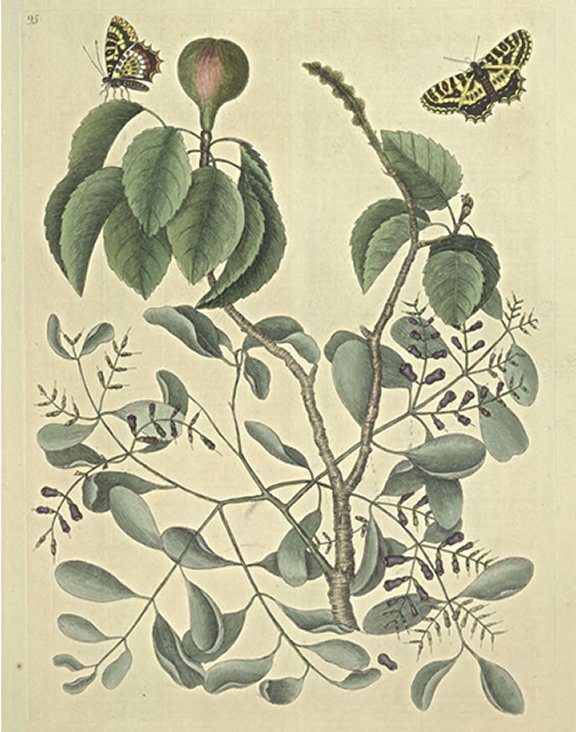Plate Number: II 95Mancanilla Pyri facie: The Mancaneel-Tree These Trees usually grow to a large Size, having a light coloured smooth Bark, under which is contained a white milky Juice, of a very poisonous Nature; the Leaves are smooth, serrated, some- what short, and pointed. The Flowers grow at the Ends of the Branches, consisting of small Tufts of very little yellow pappous Blossoms, placed at Intervals, the Length of about three Inches: The Fruit was the Size of the Figure, growing erect, and shaped like a Pear, or rather a Fig; but not being ripe, or even full grown, I had no Opportunity of seeing its Seeds, which Sir Hans Sloane, in his Nat. Hist. of Jamaica says are several, somewhat resembling those of a Melon, and are contain'd in a roundish very hard Stone, with many sharp Points on each Side of it. The Wood of this Tree is close grained, very heavy and durable, beautifully shaded with dark, and lighter Streaks, for which it is in great Esteem for Tables and Cabinets, and other curious Works in Joynery; but the virulent and dangerous Properties of these Trees, causes a general Fear, or at least Caution, in felling them; this I was not sufficiently satisfyed of, 'till assisting in the cutting down a Tree of this Kind on Andros Island, I paid for my Incredulity, some of the milky poisonous Juice spurting in my Eyes, I was two Days totally deprived of Sight, and my Eyes, and Face, much swelled, and felt a violent pricking Pain, the first twenty-four Hours, which from that Time abated gradually with the Swelling, and went off without any Application, or Remedy, none in that uninhabited Island being to be had: It is no Wonder that the Sap of this Tree should be so virulent, when Rain or Dew, falling from its Leaves on the naked Flesh, causes Blisters on the Skin, and even the Effluvia of it are so noxious as to affect the Senses of those which stand any Time under its Shade: Other malignant Effects are commonly attributed to it, but t think with little Probability, one Charge of their pernicious Quality is, that Animals which feed on the Fruit, are so infected by it that Death is often the Fate of those that feed on such Animals: this is refuted in the Instance of Guana's feeding on the Apples of Mancaneel without Harm to those who eat these same Guano's, p. 64. Vol. II the Report also that the Baracoudas and other Fish receive their poisonous Quality by feeding on Mancaneel Apples, this is likewise erroneous, there being very few of these trees on those of the Bahama Islands, I was at, and none growing on the Sea-shore, nor within many Miles of those Parts of the Bahama Seas, where these infectious Fish are known to abound; and admitting they were in Plenty, the Nature and Position of the Land admits of no Conveyance by Channels or other-wise into the Sea. Thus it is evident that the Fruit of three Trees will not infect the Flesh of Animals, and supporting they had that Effect, the Quantity of the Fruit, received into the Sea, would not be sufficient to infect the thousandth Part of the Fish that are generally known to be poisonous. As to the real Cause of poison Fish in the Bahama Seas, and elsewhere near the Tropicks, I shall attempt to account for it in another Place. In the mean Time I beg Leave to refer to the above learned Author, who has given farther Particulars relating to this remarkable Tree in his Natural History of Jamaica, Vol. II, p. 4. Viscum foliis latioribus; baccis purpureis pediculis incidentibusThe Leaves of this Misleto grow by Pairs, they are narrow at their Beginning, and broad at their Ends, set on slender pliant Stalks, growing confusedly, after the Manner of the common Mifleto; between every Pair of Leaves shoots forth two slender Stalks of about three Inches long, with Pairs of oblong purple coloured Berries, set opposite to each other. These Plants I found growing on many of the Mancaneel Trees, but did not observe them on any other Tree. Papilio medius, Gadetanus, ex nigro &sulphureo varius, maculis coccineis notatusThe upper Part of the Body of this Fly is black, with two Rows of red Spots, below which on each Side are the like Number of white Spots; the upper Sides of the four Wings are variously marked with yellow, brown, and red Spots, which last are all encompassed with brown: The under Part of the Wings are differently marked, tho' with the same Colours, except that the two lower Wings have a large Portion of white. |